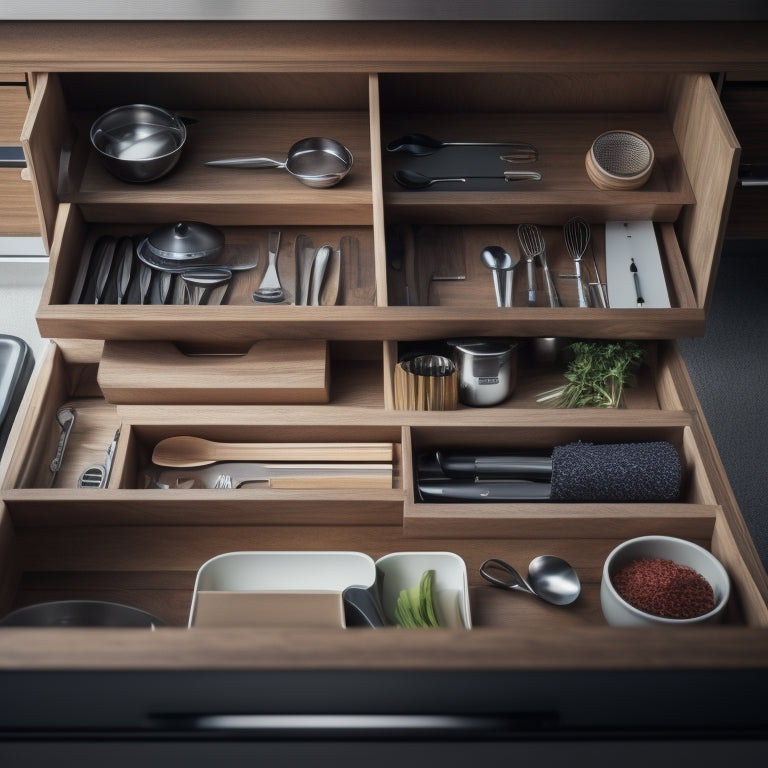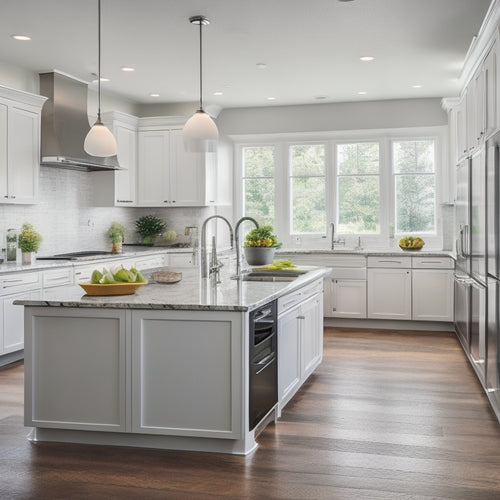
Create Your Own Kitchen Drawer Organizer System
Share
You'll begin by evaluating your kitchen drawer space, emptying and categorizing items to identify areas that need attention. Then, choose materials that are durable, functional, and aesthetically pleasing. Design your organizer system based on precise measurements, considering your personal style and the items you need to store. Build and install components, ensuring a sturdy frame and even corners. Finally, maximize storage and accessibility by allocating zones, optimizing ergonomics, and using tiered storage and adjustable dividers. With these steps, you'll be well on your way to creating a customized kitchen drawer organizer system that streamlines your workflow and improves your kitchen experience - and there's more to explore to make it truly exceptional.
Key Takeaways
• Assess your kitchen drawer space by emptying and categorizing items to identify areas needing attention and prioritize frequent-use items.
• Choose durable materials that fit your kitchen style, considering factors like weight, humidity, and temperature.
• Design a tailored organizer system with precise measurements, considering personal style and ergonomic principles.
• Construct components like dividers and trays, ensuring a straight frame and addressing corner challenges.
• Maximize storage and accessibility with zones, tiered storage, and adjustable dividers, and consider ergonomic design principles.
Assessing Your Kitchen Drawer Space
You likely open and close your kitchen drawers daily, but take a closer look at the space inside them now to identify the areas that need the most organizational attention.
Start by emptying each drawer and sorting items into categories. This will help you visualize how you can group similar items together and allocate space accordingly. Drawer categorization is key to creating a functional kitchen drawer organizer system.
Prioritize the areas that need the most attention, such as the 'junk drawer' or the drawer with the most clutter. Consider the items you use most frequently and allocate space near the front of the drawer for easy access. Less frequently used items can be stored towards the back.
Space prioritization is essential to maximizing the use of your drawer space. Take note of any awkward corners or narrow spaces that may require special attention. By evaluating your kitchen drawer space, you'll be able to create a tailored organizer system that meets your specific needs and helps you stay organized.
Choosing the Right Materials
With your kitchen drawer space assessed and prioritized, it's time to select the materials that will help you create a functional and efficient organizer system. You'll want to choose materials that are durable, cost-efficient, and easy to work with. Here are some options to take into account:
| Material | Durability | Cost Efficiency |
|---|---|---|
| Wood (e.g., plywood or MDF) | High | Moderate |
| Plastic (e.g., acrylic or PVC) | Medium | Low |
| Metal (e.g., aluminum or steel) | High | High |
When selecting materials, think about the weight and size of the items you'll be storing, as well as the humidity and temperature conditions in your kitchen. For example, if you live in a humid climate, you may want to avoid wood or opt for a water-resistant treatment. You should also consider the aesthetic appeal of the materials and how they'll fit with your kitchen's style. By choosing the right materials, you'll make sure your organizer system is both functional and visually appealing.
Designing Your Organizer System
Now that you've selected your materials, it's essential to create a detailed design for your organizer system, considering the specific dimensions of your kitchen drawer and the items you'll be storing. Measure your drawer's interior and identify the areas you want to dedicate to specific items, such as utensils, cookware, or food storage containers.
Think about your personal style and aesthetic considerations, too. Do you prefer a modern, sleek look or a more rustic, traditional feel? This will help you decide on the layout and configuration of your organizer system.
Consider the frequency of use and accessibility of each item. You'll want to place frequently used items in easy-to-reach locations, while less-used items can be stored towards the back or in harder-to-reach areas. Make sure to leave enough space between compartments to accommodate different sizes and shapes of items.
You can sketch out a rough design on paper or use online design tools to visualize your organizer system. Take your time and be patient – a well-planned design will make all the difference in the functionality and usability of your final product.
Building and Installing Components
Measuring and cutting your materials to precise specifications, start constructing the individual components of your organizer system, from dividers and compartments to trays and inserts. This is where your design plans come to life.
Begin by building the frame of your organizer, using the measurements you took earlier. Then, move on to creating the individual components, such as dividers, compartments, and trays.
When building your components, keep the following tips in mind:
- Use a level to verify your frame is straight and even
- Sand your materials to smooth out any rough edges
- Use a drill press for precise hole drilling
- Consider using a jig to simplify the construction process
As you build, don't forget to address those pesky corner challenges by using corner brackets or specialized corner pieces. You'll also want to think about handle options, such as knobs, pulls, or even soft-close slides.
Maximizing Storage and Accessibility
Maximizing Storage and Accessibility
Organize your kitchen essentials efficiently by allocating specific zones for frequently used items, such as utensils, spices, and cooking supplies, and reserving harder-to-reach areas for less frequently used items. This approach guarantees that you can quickly access what you need when you need it, saving you time and effort.
To optimize your kitchen drawer organizer system, consider the following ergonomic design principles:
| Design Element | Benefits |
|---|---|
| Tiered storage | Increases visibility and accessibility of items |
| Adjustable dividers | Allows for customization to fit your specific needs |
| Soft-close drawers | Reduces noise and prevents accidental slamming |
| Pull-out trays | Enables easy access to items in the back of the drawer |
Frequently Asked Questions
Can I Adapt This System to Fit Non-Standard Drawer Sizes?
You're not limited by standard drawer sizes - take matters into your own hands! Measure your unique space, then adapt with custom measurements and adjustable dividers to craft a tailored system that fits like a glove.
How Do I Keep the Organizer System Clean and Dust-Free?
To keep your organizer system clean and dust-free, you'll want to prioritize daily maintenance, such as wiping down surfaces and tidying up contents, as well as regular inspection to make sure everything stays in its place.
Are There Any Eco-Friendly Material Options for the Organizer?
When choosing materials for your organizer, you'll find eco-friendly options like sustainable woods, such as bamboo or reclaimed wood, and recycled plastics that reduce waste, letting you create a system that's both functional and environmentally conscious.
Can I Add Decorative Elements to the Organizer Design?
"Who says organization has to be boring? You can totally add some flair! Choose a color scheme that resonates with your style, incorporate pattern play to add visual interest, and make your organizer a stunning reflection of you."
Is It Possible to Move the Organizer to a Different Kitchen in the Future?
When planning a move, you'll want to take into account portability concerns. Fortunately, you've been future-proofing your design, so you can easily disassemble and reassemble your organizer in your new kitchen, making the shift smooth and stress-free.
Related Posts
-

5 U-Shaped Kitchen Layout Ideas to Revamp Your Space
You're about to reveal the secret to a kitchen that's both stunning and supremely functional, where every inch of spa...
-

Deighton Associates Awarded for Excellence in Asset Management
You're likely curious about Deighton Associates' recent recognition for excellence in asset management. They've recei...

